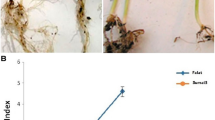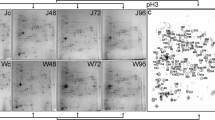Abstract
Aims
Fusarium oxysporum is a causal disease that threatens watermelon production, but little information on the molecular mechanisms involved in host defense is available. To understand the defense response, a proteome-level changes that occur in watermelon roots during F. oxysporum infection were investigated.
Methods
We utilized two-dimensional gel electrophoresis (2-DE) to compare changes in the root proteome profiles and validated their expression using real-time PCR.
Results
A total of 690 spots were detected, and 32 proteins had significant changes in abundance and were further identified by mass spectrometry. These proteins were mainly involved in metabolism, stress and defense and amino acid biosynthesis. RT-PCR analysis revealed that transcripts corresponding to the nine randomly selected proteins could be significantly induced, their expression patterns were consistent with the proteomic results except for Apx and Tdh. The involvement of these proteins in regulating watermelon response against F. oxysporum is discussed.
Conclusions
The reprogrammed proteins were involved in several biological processes, which indicates that watermelon can directly alter the abundance of these proteins to establish a defense response. This work helps us understand the basic processes during the watermelon-F. oxysporum interaction and may contribute to improve resistance breeding toward this pathogen.





Similar content being viewed by others
References
Afroz A, Ali GM, Mir A, Komatsu S (2011) Application of proteomics to investigate stress induced proteins for improvement in crop protection. Plant Cell Rep 30:745–763
Baayen RP, Van Eijk C, Elgersma DM (1989) Histology of roots of resistant and susceptible carnation cultivars from soil infested with Fusarium oxysporum f. Sp. dianthi. Eur J Plant Pathol 95:3–13
Baena-González E, Sheen J (2008) Convergent energy and stress signaling. Trends Plant Sci 13:474–482
Bian YW, Lv DW, Cheng ZW, Gu AQ, Cao H, Yan YM (2015) Integrative proteome analysis of Brachypodium distachyon roots and leaves reveals a synergetic responsive network under H2O2 stress. J Proteome 128:388–402
Bradford MM (1976) A rapid and sensitive method for the quantitation of microgram quantities of protein utilizing the principle of protein-dye binding. Anal Biochem 72:248–254
Carlsen SCK, Understrup A, Fomsgaard IS, Mortensen AG, Ravnskov S (2008) Flavonoids in roots of white clover: interaction of arbuscular mycorrhizal fungi and a pathogenic fungus. Plant Soil 302:33–43
Casati P, Drincovich MF, Edwards GE, Andreo CS (1999) Malate metabolism by NADP-malic enzyme in plant defense. Photosynth Res 61:99–105
Chang PFL, Hsu CC, Lin YH, Chen KS, Huang JW, Liou TD (2008) Histopathology comparison and phenylalanine ammonia lyase (PAL) gene expressions in fusarium wilt infected watermelon. Aust J Agric Res 59:1146–1155
Cipriano AKAL, Gondim DMF, Vasconcelos IM, Martins JAM, Moura AA, Moreno FB et al (2015) Proteomic analysis of responsive stem proteins of resistant and susceptible cashew plants after Lasiodiplodia theobromae infection. J Proteome 113:90–109
De Bruyne L, Höfte M, De Vleesschauwer D (2014) Connecting growth and defense: the emerging roles of brassinosteroids and gibberellins in plant innate immunity. Mol Plant 7:943–959
Ding W, Smulan LJ, Hou NS, Taubert S, Watts JL, Walker AK (2015) s-Adenosylmethionine levels govern innate immunity through distinct m ethylation-dependent pathways. Cell Metab 22:633–645
Fernández-garcía N, Carvajal M, Olmos E (2004) Graft union formation in tomato plants: peroxidase and catalase involvement. Ann Bot 93:53–60
Garrett SD (1970) Pathogenic root-infecting fungi. University Press, Cambridge
Guo SG, Zhang JG, Sun HH, Salse J, Lucas WJ, Zhang HY et al (2013) The draft genome of watermelon (Citrullus lanatus) and resequencing of 20 diverse accessions. Nat Genet 45:51–58
Heyno E, Alkan N, Fluhr R (2013) A dual role for plant quinone reductases in host-fungus interaction. Physiol Plantaru 149:340–353
Hinault MP, Ben-Zvi A, Goloubinoff P (2006) Chaperones and proteases: cellular fold-controlling factors of proteins in neurodegenerative diseases and aging. J Mol Neurosci 30:249–265
Imahori Y (2014) Role of ascorbate peroxidase in postharvest treatments of horticultural crops. P. Ahmad (Ed.), Oxidative damage to plants: antioxidant networks and signaling, Elsevier Inc., San Diego, pp 425-451
Jiang Y, Chen X, Ding X, Wang Y, Chen Q, Song WY (2013) The XA21 binding protein XB25 is required for maintaining XA21-mediated disease resistance. Plant J 73:814–823
Kadota Y, Shirasu K, Guerois R (2010) NLR sensors meet at the SGT1-HSP90 crossroad. Trends Biochem Sci 35:199–207
King SR, Davis AR, Liu WG, Levi A (2008) Grafting for disease resistance. Hortscience 43:1673–1676
Leshem Y, Melamed-Book N, Cagnac O, Ronen G, Nishri Y, Solomon M et al (2006) Suppression of Arabidopsis vesicle-SNARE expression inhibited fusion of H2O2-containing vesicles with tonoplast and increased salt tolerance. Proc Natl Acad Sci U S A 103:18008–18013
Li X, Bonawitz ND, Weng JK, Chapple C (2010) The growth reduction associated with repressed lignin biosynthesis in Arabidopsis thaliana is independent of flavonoids. Plant Cell 22:1620–1632
Liebrand TW, van den Berg GC, Zhang Z, Smit P, Cordewener JHG, America AHP et al (2013) Receptor-like kinase SOBIR1/EVR interacts with receptor-like proteins in plant immunity against fungal infection. Proc Natl Acad Sci U S A 110:10010–10015
Liu Y, Bruch-Smith T, Schiff M, Feng S, Dinesh-Kumar SP (2004) Molecular chaperone Hsp90 associates with resistance protein N and its signaling proteins SGT1 and Rar1 to modulate an innate immune response in plants. J Biol Chem 279:2101–2108
Liu YM, Du HM, He XX, Huang BR, Wang ZL (2012) Identification of differentially expressed salt-responsive proteins in roots of two perennial grass species contrasting in salinity tolerance. J Plant Physiol 169:117–126
Livak KJ, Schmittgen TD (2001) Analysis of relative gene expression data using real-time quantitative PCR and the 2-ΔΔCT method. Methods 25:402–408
López-Gresa MP, Maltese F, Bellés JM, Conejero V, Kim HK, Choi YH et al (2009) Metabolic response of tomato leaves upon different plant-pathogen interactions. Phytochem Anal 21:89–94
Macho AP, Zipfel C (2014) Plant PRRs and the activation of innate immune signaling. Mol Cell 54:263–272
Martyn RD (1996) Fusarium wilt of watermelon. In: Zither TA, Hopkins DL, Thomas CA (eds) Compendium of cucurbit diseases. The American Phytopathology Society, St. Paul, MN, pp 13–14
Mazel A, Leshem Y, Tiwari BS, Levine A (2004) Induction of salt and osmotic stress tolerance by overexpression of an intracellular vesicle trafficking protein AtRab7 (AtRabG3e). Plant Physiol 134:118–128
Meru G, McGregor C (2016) Genotyping by sequencing for SNP discovery and genetic mapping of resistance to race 1 of Fusarium oxysporum in watermelon. Sci Hortic 209:31–40
Mhamdi A, Noctor G (2015) Analysis of the roles of the Arabidopsis peroxisomal isocitrate dehydrogenase in leaf metabolism and oxidative stress. Environ Exp Bot 114:22–29
Miernyk JA, Thelen JJ (2008) Biochemical approaches for discovering protein-protein interactions. Plant J 53:597–609
Mittler R, Zilinskas BA (2004) Activated oxygen species in multiple stress situations and protective systems. In: Sandermann H (ed) Molecular ecotoxicology of plants, Springer. Berlin Heidelberg, New York, pp 51–73
Mohr U, Lange J, Boller T, Wiemken A, Vögeli-Lange R (1998) Plant defense genes are induced in the pathogenic interaction between bean roots and Fusarium solani, but not in the symbiotic interaction with the arbuscular mycorrhizal fungus Glomus mosseae. New Phytol 138:589–598
Moreira RC, Lima JS, Silva LGC, Cardoso JE (2013) Resistance to gummosis in wild cashew genotypes in northern Brazil. Crop Prot 52:10–13
Mourad G, King J (1995) L-O-Methylthreonine-resistant mutant of Arabidopsis defective in isoleucine feedback regulation. Plant Physiol 107:43–52
Mueller-Uri F, Parthier B, Nover L (1988) Jasmonate-induced alteration of gene expression in barley leaf segments analyzed by in-vivo and in-vitro protein synthesis. Planta 176:241–247
Münzenberger B, Otter T, Wüstrich D, Polle A (1997) Peroxidase and laccase activities in mycorrhizal and non-mycorrhizal roots of Norway spruce (Picea abies L.) and larch (Larix decidua). Can J Bot 75:932–938
Navarro L, Bari R, Achard P, Lisón P, Nemri A, Harberd NP et al (2008) DELLAs control plant immune responses by modulating the balance and salicylic acid signaling. Curr Biol 18:650–655
Ochi A, Hori H (2007) Hydroxyl radical probing of rRNA (Gm18) methyltransferase [TrmH]-AdoMet-artificial rRNA ternary complex. Nucleic Acids Symp Ser 51:373–374
Parrott DL, Huang L, Fischer AM (2016) Downregulation of a barley (Hordeum vulgare) leucine-rich repeat, non-arginine-aspartate receptor-like protein kinase reduces expression of numerous genes involved in plant pathogen defense. Plant Physiol Bioc 100:130–140
Patridge EV, Ferry JG (2006) WrbA from Escherichia coli and Archaeoglobus fulgidus is an NAD (P) H: Quinone oxidoreductase. J Bacteriol 188:3498–3506
Piterková J, Luhová L, Mieslerová B, Lebeda A, Petřivalský M (2013) Nitric oxide and reactive oxygen species regulate the accumulation of heat shock proteins in tomato leaves in response to heat shock and pathogen infection. Plant Sci 207:57–65
Roje S (2006) S-adenosyl-L-methionine: beyond the universal methyl group donor. Phytochemistry 67:1686–1698
Romeo S, Trupiano D, Ariani A, Renzone G, Scippa GS, Scaloni A et al (2014) Proteomic analysis of Populus × euramericana (clone I-214) roots to identify key factors involved in zinc stress response. J Plant Physiol 171:1054–1063
Saidi Y, Finka A, Muriset M, Bromberg Z, Weiss YG, Maathuis FJM et al (2009) The heat shock response in moss plants is regulated by specific calcium-permeable channels in the plasma membrane. Plant Cell 21:2829–2843
Schmid KM, Patterson GW (1988) Effects of cyclopropenoid fatty acids on fungal growth and lipid composition. Lipids 23:248–252
Shibata Y, Kawakita K, Takemoto D (2011) SGT1 and HSP90 are essential for age-related non-host resistance of Nicotiana benthamiana against the oomycete pathogen Phytophthora infestans. Physiol Mol Plant 75:120–128
Shirasu K (2009) The HSP90-SGT1 chaperone complex for NLR immune sensors. Annu Rev Plant Biol 60:139–164
Sinha R, Chattopadhyay S (2011) Changes in the leaf proteome profile of Mentha arvensis in response to Alternaria alternate infection. J Proteome 74:327–336
Stenlid MH, Ahlsson F, Forslund A, von Döbeln U, Gustafsson J (2014) Energy substrate metabolism in pyruvate dehydrogenase complex deficiency. J Pediatr Endocrinol Metab 27:1059–1064
Tena G, Boudsocq M, Sheen J (2011) Protein kinase signaling networks in plant innate immunity. Curr Opin Plant Biol 14:519–529
Treutter D (2006) Significance of flavonoids in plant resistance: a review. Environ Chem Lett 4:147
Wang YS, Pi LY, Chen X, Chakrabarty PK, Jiang J, De Leon AL et al (2006) Rice XA21 binding protein 3 is a ubiquitin ligase required for full Xa21-mediated disease resistance. Plant Cell 18:3635–3646
Yang YJ, Wang LP, Tian J, Li J, Sun J, He LZ et al (2012) Proteomic study participating the enhancement of growth and salt tolerance of bottle gourd rootstock-grafted watermelon seedlings. Plant Physiol Bioc 58:54–65
Yoshimura K, Masuda A, Kuwano M, Yokota A, Akashi K (2008) Programmed proteome response for drought avoidance/tolerance in the root of a C3 xerophyte (wild watermelon) under water deficits. Plant Cell Physiol 49:226–241
Zhang M, Xu JH, Liu G, Yao XF, Li PF, Yang XP (2015a) Characterization of the watermelon seedling infection process by Fusarium oxysporum f.Sp. niveum. Plant Pathol 64:1076–1084
Zhang M, Yang XP, Xu JH, Liu G, Yao XF, Li PF (2015b) Physiological responses of watermelon grafted onto bottle gourd to Fusarium oxysporum f. Sp. niveum infection. Acta Hortic 1086:107–111
Zhao C, Smith EC, Whiteheart SW (2011) Requirements for the catylytic cycle of the N-ethylmaleimide-sensitive factor (NSF). Biochim Biophys Acta 1823:159–171
Zhou XG, Everts KL, Bruton BD (2010) Race 3, a new and highly virulent race of Fusarium oxysporum f. Sp. niveum causing fusarium wilt in watermelon. Plant Dis 94:92–98
Zvirin T, Herman R, Brotman Y, Denisov Y, Belausov E, Freeman S et al (2010) Differential colonization and defence responses of resistant and susceptible melon lines infected by Fusarium oxysporum race 1.2. Plant Pathol 59:576–585
Acknowledgements
This work was supported by National Industrial Technology System for Watermelon & Melon. Title: Breeding of Grafting Rootstocks for Watermelon & Melon (CARS-NO.26), and Jiangsu Provincial Support Program for Agriculture, 2015 to 2017. Title: Innovation and integrated application of commercial chain techniques of good product direct selling to e-commerce and store in Watermelon [CX(15)1018].
Author information
Authors and Affiliations
Corresponding author
Additional information
Responsible Editor: Stéphane Compant.
Electronic supplementary material
Supplementary Table S1
(DOCX 17 kb)
Supplementary Table S2
(DOCX 17 kb)
Rights and permissions
About this article
Cite this article
Zhang, M., Xu, J., Liu, G. et al. Proteomic analysis of responsive root proteins of Fusarium oxysporum-infected watermelon seedlings. Plant Soil 422, 169–181 (2018). https://doi.org/10.1007/s11104-017-3294-x
Received:
Accepted:
Published:
Issue Date:
DOI: https://doi.org/10.1007/s11104-017-3294-x




